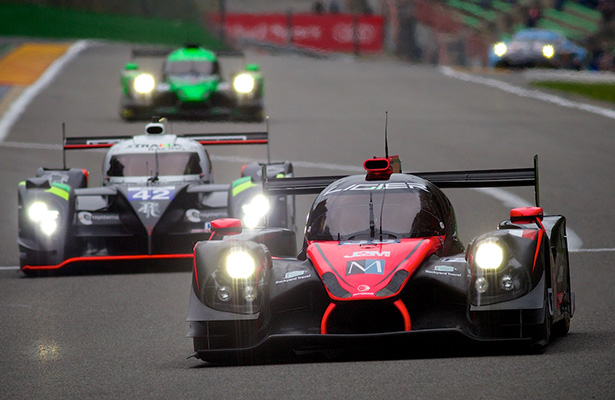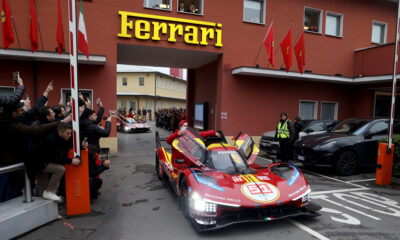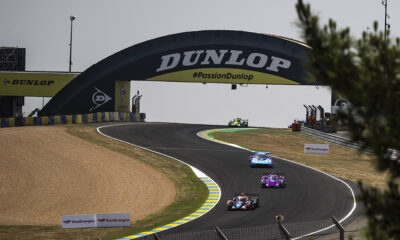
Photo: John Dagys
With a 19-car field featuring 11 different chassis name and engine combinations, the LMP2 class at this year’s 24 Hours of Le Mans is both high on diversity and overall car count.
But with the impending release of the new 2017 global LMP2 regulations, which will see only four constructors and a spec engine selected, those days of diversity may be numbered.
Much of 2015 and 2016 will see teams competing in the FIA World Endurance Championship, TUDOR United SportsCar Championship and European Le Mans Series all looking to acquire their next piece of machinery, and they’ll have a smaller pool to draw from.
Still, while there are no more than three of any particular package in LMP2 in this year’s Le Mans, one constructor still leads the way in terms of machinery on track, in the form of Onroak Automotive.
With nine cars entered, seven Ligier JS P2 coupes split three-three-one between Nissan, Honda and Judd, and two of the venerable open-top Morgan prototypes, Onroak’s entry matches Porsche for the most number of chassis in the overall field.
ORECA is next up in LMP2 with four cars, split two-two between the Oreca 03R and new Oreca 05 coupe.
It is highly likely that Onroak would be among the four constructors selected. OAK Racing team principal Philippe Dumas downplayed expectations, although he anticipates Onroak will remain a prominent part of the LMP2 future.
“I don’t know if we are confident or not, but to be honest, when you have nine chassis in Le Mans 24 Hours, it’s not pretentious to say that we would be in the top four for sure,” Dumas told Sportscar365. “So we try to prepare the best we can.”
Through no fault of their own, Scott Sharp’s Tequila Patron ESM team has almost been through four different chassis this year alone.
The year began with the new HPD ARX-04b, which ran only at the Rolex 24 at Daytona before it was dropped per consistent teething issues. The car was not homologated prior to the start of the WEC season.
Meanwhile an interim switch to the team’s old HPD ARX-03b followed for the Twelve Hours of Sebring and Six Hours of Silverstone, before the team debuted its pair of new Ligier JS P2 Hondas at Spa-Francorchamps.
Sharp, team owner and driver, said he wouldn’t have made the investment in the Ligiers if he didn’t think they would be part of the future.
But he also said that losing the luster of class diversity could eventually be a detriment to the class down the road.
“For me, getting pretty into this, talking to a lot of different people, you like to see technical innovation, as the P2 grid is this year,” Sharp told Sportscar365. “We have all these different cars, different looks.
“I do understand from a manufacturer perspective, it’s hard to make the ends meet if you’re not selling a fair amount of cars. If it’s spread over 10-11 manufacturers, it’s pretty hard to do that.”
Dumas concurred with Sharp’s assessment from a business point of view.
“For the business plan, at the moment it’s quite tough with the cost cap,” Dumas said. “Overall it’s important for us with P2 and P3 to earn money and have a real business model. It’s quite important.”
Speaking from another privateer perspective without a major manufacturer tie-in, Jota Sport team principal Sam Hignett said teams will need to have faith in the ACO’s direction.
Hignett enters this week as defending Le Mans race winners with the then-Zytek Z11SN Nissan, now Gibson 015S-Nissan.
“Is it disappointing? We just have to have the faith that the ACO are doing it for the right reasons, and they could see into the future and know what needs to happen,” Hignett told Sportscar365.
“I think they’ve got a good grasp on the situation. They’ll know what’s going to happen. The grid is the size of the grid now by calls they’ve made.
“Although this call has ruffled a few feathers, we’ve got to believe it was the correct call to make.”
Hignett and Sharp differed on the prospect of a spec engine.
“In fairness that’s not going to make any difference,” Hignett said. “The Nissan is virtually the spec engine; there’s a couple of Judd engines out there. I don’t see that making a big difference at all.
“If all of this goes towards bringing costs down, then yes, that’ll help increase the size of the grid, which would be great.”
Sharp countered, “I would think they’d want to keep the engine more open. I don’t see the benefit to making a sole supplier. It seems too much of a spec class for that, frankly.
“Look at Honda. Honda’s not going to become a P1 manufacturer. If they don’t end up [getting the engine side], and it sounds like they won’t get the engine side, they’re not going to be involved anymore.
“I don’t quite understand why you wouldn’t want to have Honda or other manufacturers involved.”
Regardless of how it pans out, this weekend’s race in LMP2 should be a barnburner.
Jota’s trio of Oliver Turvey, Simon Dolan and Harry Tincknell picked up where OAK Racing left off in-race last year, as the Ligier JS P2 Nissan was poised for a debut win but fell victim to late race mechanical issues that slowed the trio of Alex Brundle, Jann Mardenborough and Mark Shulzhitskiy.
Hignett said the focus has to remain on the present, and that there’s no going back in terms of the future regulations for the class.
“At the end of the day people have made steps to stop it happening, but it’s not going to stop happening.”
























